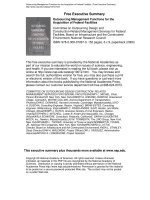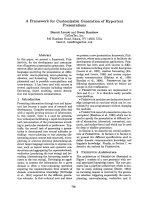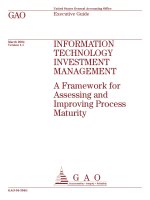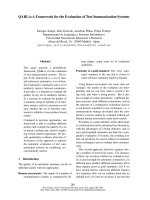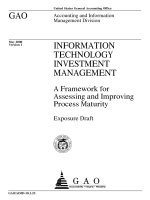SUSTAINABLE FACILITIES MANAGEMENT FRAMEWORK FOR ASSESSING PERFORMANCE OF EXISTING OFFICE BUILDINGS
Bạn đang xem bản rút gọn của tài liệu. Xem và tải ngay bản đầy đủ của tài liệu tại đây (903.05 KB, 177 trang )
SUSTAINABLE FACILITIES MANAGEMENT FRAMEWORK FOR ASSESSING
PERFORMANCE OF EXISTING OFFICE BUILDINGS
DIANA LAI NGIIK CHUI
(B.Sc. Building (Hons), NUS)
A THESIS SUBMITTED
FOR THE DEGREE OF MASTER OF SCIENCE (BUILDING)
DEPARTMENT OF BUILDING
NATIONAL UNIVERSITY OF SINGAPORE
2012
___________________________________________________________
DECLARATION
_____________________________________________________________________
I hereby declare that this thesis is my original work and it has been written by me in
its entirely. I have duly acknowledged all the sources of information which have been
used in the thesis.
This thesis has also not been submitted for any degree in any university previously.
Diana Lai Ngiik Chui
29 August 2012
iii
___________________________________________________________
ACKNOWLEDGEMENTS
_____________________________________________________________________
I would like to express my greatest gratitude to the people who made this dissertation
possible.
First of all, I would like to sincerely thank my supervisor, Dr. Florence Ling Yean
Yng, for her guidance, patience, valuable inputs, and her precious time during the
whole research process. Her mentorship is great and paramount to the completion of
this dissertation.
I appreciate all the respondents for their active participation in the exploratory study
and survey questionnaires. Their time and efforts in responding to my interviews and
surveys made this research possible.
I would also like to thank my family members, who gave their full moral supports and
encouragement to me during this period. They were willing to listen to me whenever I
encountered difficulties.
Finally, I would like to thank all others who have in one way or another helped me to
make this study possible.
iiiii
___________________________________________________________
TABLE OF CONTENTS
_____________________________________________________________________
Page
DECLARATION
i
ACKNOWLEDGEMENTS
ii
TABLE OF CONTENTS
iii
SUMMARY
x
LIST OF TABLES
xiii
LIST OF FIGURES
xv
LIST OF EQUATIONS
xvi
ABBREVIATION
xvii
CHAPTER 1
INTRODUCTION
1.1
Background
1
1.2
Research Problems and Importance of Study
2
1.3
Research Objectives
3
1.4
Research Hypothesis
4
1.5
Research Scope
5
iviii
1.6
Research Methodology
6
1.7
Structure of Dissertation
7
CHAPTER 2
LITERATURE REVIEW OF FACILITIES MANAGEMENT (FM)
2.1
Overview of Chapter
10
2.2
Definitions of Facilities Management (FM)
10
2.3
Drivers for Growth in Facilities Management (FM)
13
2.4
2.3.1
Government Policies
2.3.2
Global Competition
2.3.3
Environmental Awareness
2.3.4
Diversification in Workforce
2.3.5
Outsourcing FM Services
The Relationship Between Business and Facilities
16
Management’s (FM) Functions
2.5
Summary of Chapter
18
CHAPTER 3
LITERATURE REVIEW OF SUSTAINABLE DEVELOPMENT AND
CONCEPTUAL FRAMEWORK OF SUSTAINABLE FACILITIES
MANAGEMENT (SFM)
3.1
Overview of Chapter
19
iv v
3.2
Demands on FM To Deliver Sustainable Built Environment
19
3.3
Sustainable Development
21
3.4
Drivers For The Growth Of Sustainable Facilities Management
24
(SFM)
3.4.1 Awareness on Environmental Issues
3.4.2 Environmental Building Assessment Method For
Existing Building
3.4.3
Increased In Existing Building Stock
3.4.4 Advancement In Building Technologies
3.5
3.6
Sustainable Facilities Management Variables
3.5.1
Economic Sustainability
3.5.2
Social Sustainability
3.5.3
Environmental Sustainability
Conceptual Framework For Sustainable Facilities Management
29
41
(SFM)
3.7
Summary of Chapter
43
CHAPTER 4
LITERATURE REVIEW ON EXISTING BUILDING PERFORMANCE
ASSESSMENT METHODS
4.1
Overview of Chapter
44
4.2
Role of Building Assessment Tools
44
4.3
Current Environmental Building Assessment Methods for
45
viv
Existing Buildings
4.3.1 LEED-EB
4.3.2 BREEAM
4.3.3 BEPAC
4.3.4 NABERS
4.3.5 CASBEE
4.3.6 Green Mark for Existing Buildings
4.3.7 HK-BEAM for Existing Buildings
4.4
Singe-Dimensional Versus Multiple-Dimensional Approach
61
4.5
Summary of Chapter
63
CHAPTER 5
RESEARCH METHOD
5.1
Overview of Chapter
64
5.2
Research Design
64
5.3
Data Collection Method
66
5.4
Data Collection Instrument
68
5.4.1
Section A: Building Information
5.4.2 Section B: Performance Measurement
5.4.3 Section C: SFM Practices and Their Importance
5.4.4 Section D: Background information of Respondent and
Organisation
5.5
Sampling
76
vii
vi
5.6
Data Analysis Methodology
77
5.7
Summary of Chapter
79
CHAPTER 6
CHARACTERISTICS OF SAMPLES
6.1
Overview of Chapter
80
6.2
Exploratory Study
80
6.3
Pilot Study
81
6.4
Survey Questionnaire
82
6.4.1 Characteristics of Respondents
6.5
6.4.2
Characteristics of Office Building Samples
6.4.3
Building Management and Performance Profiles
Summary of Chapter
86
CHAPTER 7
RESULTS AND DISCUSSION
7.1
Overview of Chapter
87
7.2
Comparing Building Performance of GM And Non-FM Offices
87
7.3
Correlations between Sustainability Variables and Performance
97
of the Electricity and Water Usage
7.4
Respondents’ Perceptions on the importance variables in
viii
vii
102
Sustainable Facilities Management
7.4.1 Economic Sustainability
7.4.2 Social Sustainability
7.4.3 Environment Sustainability
7.5
Summary of Chapter
109
CHAPTER 8
PROPOSED SUSTAINABLE FACILITIES MANAGEMENT FRAMEWORK
8.1
Overview of Chapter
112
8.2
Multi-attribute Value Theory (MAVT) for Multiple Criteria
112
Decision Analysis (MCDA)
8.3
Application of Sustainable Facilities Management Indices
124
(SFMIndices) Through A Case Study
8.3.1 Background of Building A
8.3.2 Characteristics of key informants
8.3.3 Evaluating Building A’s SFM Performance
8.3.4 Usefulness of SFM Indices
8.4
Summary of Chapter
133
CHAPTER 9
CONCLUSION AND RECOMMENDATION
ixviii
9.1
Summary of Chapter
135
9.2
Validation Of Hypothesis And Main Findings
136
9.3
Contribution to Knowledge
139
9.4
Contribution to Facilities Management Practices
140
9.5
Limitation of Study
141
9.6
Conclusion and Recommendations
142
9.7
Recommendations for Future Work
144
146
BIBLIOGRAPHY
APPENDIX 1 :
159
Survey Questionnaire
xix
___________________________________________________________
SUMMARY
_____________________________________________________________________
Facilities Management (FM) is a profession that is growing rapidly. The term
Sustainable FM (SFM) was introduced by several authors to integrate sustainability
principles into FM (Hodges, 2005, Nielsen et al., 2009 and Shah, 2007). The InterMinisterial Committee for Sustainable Development (IMCSD) targeted 80% of the
buildings in Singapore to obtain at least a Green Mark certification by 2030 (BCA,
2010). A Memorandum of Understanding (MOU) was signed between the Building
and Construction Authority (BCA) and International Facility Management
Association (IFMA) in 2010 to spearhead the SFM practices in Singapore to deliver a
sustainable built environment. This signifies that there is a need to have a framework
to guide firms and FM personnel in achieving SFM. The aim of this study is to
incorporate sustainable practices into FM to manage an existing building. The specific
objectives are to develop a sustainable FM framework for office buildings that
incorporates the sustainability principles: economic, social and environmental, to
construct an assessment method to evaluate an existing office building and to apply
the proposed SFMIndices with a case study.
This study focuses on the performance assessment of existing office buildings in
Singapore. Existing building assessment methods are reviewed and their strengths and
weaknesses are discussed. The variables under the three pillars of sustainability:
economic, social and environment were identified through literature review and an
exploratory study. The survey research design was adopted and data were collected
using self-administered questionnaire sent out via mail. The sample was selected
xix
using random sampling method and the response rate was 32%. Descriptive and
statistical analysis was carried out using SPSS software.
Independent sample t-test was used to study if there are significant differences
between Green Mark and non-Green Mark certified non-residential buildings. Pearson
correlation analysis was adopted to examine the relationships between the
independent variables and energy and water consumption. Subsequently, respondents
were asked to rate the importance of each variable to achieve SFM using one sample
t-test.
The results show that GM and non-GM certified buildings adopted significantly
different FM practices and policies. There are significant relationships between SFM
practices and building performance. Subsequently, the means of the significant
important variables were used to construct SFMIndices. The indices ware calculated
using Multi-Attribute Value Theory (MAVT). A case study was carried out to
illustrate the application of the indices.
This study is important because existing building performance can be evaluated using
SFMIndices to integrate economic, social and environment aspects. In addition, the
proposed SFMIndices can be used as guidelines in implementing SFM and assisting a
firm’s decision making in FM. It is suggested that future research be carried out to
collect more building samples using SFMIndices and the top 10% performance can
then be used as a benchmarking tool.
xiixi
Keywords:
Sustainability,
Sustainable
facilities
management,
certification, Multi-Attribute Value Theory, Building performance
xii
xiii
Green
Mark
___________________________________________________________
LIST OF TABLES
_____________________________________________________________________
Page
Table 4.1
Rating scope under Part 1, 2 and 3 in BIU BES 5058
49
Table 4.2
Summary of Criteria for Assessment and Methods for
Assessment
60
Table 5.1
7-point Likert Scales for Section B: The extent of FM
practices adopted
66
Table 5.2
7-point Likert Scales for Section B: The extent of FM
practices adopted
67
Table 5.3
Ratio between car parking spaces to building occupants
and coding
73
Table 5.4
Distance to public transport location and coding
73
Table 5.5
Sampling design
75
Table 6.1
Profile of interviewees for exploratory study
79
Table 6.2
Profile of interviewees for pilot study
79
Table 6.3
Summary of survey response rate
80
Table 6.4
Summary of respondent profiles
81
Table 6.5
Summary of building profiles
82
Table 6.6
Summary of FM practices adopted
83
xiii
xiv
Table 7.1
Summary of GM certification for existing non-residential
building
86
Table 7.2
FM Practices practised by office buildings with GM
Award
93
Table 7.3
Item 3h: Ratio between car parking spaces to building
occupants
94
Table 7.4
Item 3i: Distance to public transport location
94
Table 7.5
Pearson Correlation results
99
Table 7.6
Descriptive statistics and One sample t-test
106
Table 8.1
Scores allocated for types of variables used
113
Table 8.2
MAVT calculations based on maximum scores
121
Table 8.3
Profile of Building Users (Employees) for case study
Building A
123
Table 8.4
Profile of Building Users (Employees) for case study
Building A
123
Table 8.5
Ratings for Building A
128
Table 9.1
Review of Research Hypotheses
133
xv
xiv
___________________________________________________________
LIST OF FIGURES
_____________________________________________________________________
Page
Figure 3.1
Share of Built Environment in Resource Use
25
Figure 3.2
Share of Built Environment in Pollution Emission
25
Figure 3.3
Energy Consumption by Sectors in 2005
26
Figure 4.1
Classification and rearrangement of assessment items into
Q (Building environmental quality and performance) and
L (Building environmental loadings)
54
Figure 8.1
Framework for SFMIndices using MAVT
122
xvi
xv
___________________________________________________________
LIST OF EQUATIONS
_____________________________________________________________________
Page
Equation 8.1
MAVT Formula
111
Equation 8.2
Additive Method for MAVT
112
xvii
xvi
___________________________________________________________
ABBREVIATION
_____________________________________________________________________
Abb.
Full Name
ACPs
AFPM
BAMP
BAS
BCA
BEPAC
BEPAS
BIS
BIU
BRE
BREEAM
CBD
CMS
EDA
EMS
ESD
FM
GFA
GM
GM-EB
HK-BEAM
IFMA
IT
KPI
LCA
LEED
LEED-EB
MAVT
MCDA
MTI
NABERS
PFI
RCM
SAM
SD
SFM
SFMIndices
UNCED
UNDPCSD
Alternative Compliance Paths
Association of Property and Facility Managers
Building Asset Management Plan
Building Automation System
Building and Construction Authority
Building Environmental Performance Assessment Criteria
Building environmental performance analysis system
Building Information System
BREEAM In-Use
Building Research Establishment
BRE Environmental Assessment Method
Central Business District
Communication Management System
Exploratory Data Analysis
Energy Management System
ecologically sustainable development
Facilities Management
Gross floor area
Green Mark
Green Mark For Existing Building
Hong Kong Building Environment Assessment Method
International Facility Management Association
Information Technology
Key performance indicators
Life Cycle Assessment
Leadership
Leadership in Energy and Environmental Design for existing building
Multi Attribute Values Theory
Multiple Criteria Decision Analysis
Ministry of Trade and Industry
National Australian Building Environmental Rating System
Private Finance Initiative
Reactive-centred Maintenance
Strategic asset management
Standard deviation
Sustainable Facilities Management
Sustainable Facilities Management Indices
United Nations Conference on Environment and Development
United Nations Department for Policy Coordination and Sustainable
Development
United Nations Division of Sustainable Development
United Nations Environment Programme
The United States Green Building Council
UNDSD
UNEP
USGBC
xvii
xviii
Abb.
Full Name
WCED
WELS
WSHA
World Commission on Environment and Development
Water Efficiency Labelling Scheme
Workplace Safety and Health Act
xix
viii
_____________________________________________________________________
CHAPTER 1:
INTRODUCTION
_____________________________________________________________________
1.1
BACKGROUND
Facilities management (FM) is an emerging discipline where it is integrated into an
organisation’s business function and no longer operate as a separate entity (Alexander,
2003; Langston and Ding, 2001). Before 1980’s, FM was viewed as non-core services
and organisations tend to cut cost in FM to maximise their business profits (Nutt,
2004; Duffy, 2000). At present, FM has been gaining emphasis in organisation to
deliver values in core business. There is a direct linkage between business and
supporting infrastructure to improve business performance (Grimshaw and Cairns,
2000). Jones (2000) suggested effective FM is able to provide long term cost savings
and add value to an organisation.
The environment where FM operates in is getting more challenging. Factors such as
business competitiveness (Alexander, 1993), environmental awareness (Angella and
Klassen, 1999), shifting into FM outsourced practices (Atkin and Brooks, 2009),
employing technologies such as Building Automation System (BAS) (Teicholz and
Ikeda, 1995), increasing aging building (IFMA, 2007), globalisation (Cotts et al.,
2010) and financing arrangement such as Private Finance Initiative (PFI) (Jones, 2000)
are contributing to the changes in FM’s roles and functions. Nutt (2004) suggested
future FM can be moved forward based on four basic resources trails available in an
organisation: financial resource trail (business), human resource trail (people),
1
physical resource trail (property), and knowledge resource trail (information). He
further suggested that FM should be strategically planned in order to exploit the
opportunities available within the four trails (Nutt, 2004).
There is an increasing demand on FM profession on their roles and responsibilities to
meet organisation needs (Alexander, 1993 and 2003). Alexander (2003) believes FM
profession needs to prepare the changes by strengthening FM personnel’s leadership
and knowledge in management. He forecasted professional bodies will slowly be
positioning FM towards more specific roles and responsibilities in an organisation
(Alexander, 2003). Sustainable development was introduced in Brundtland Report
where development meets the needs of the present without compromising the ability
for future generations to meet their own needs (WCED, 1987, p.43). The sustainable
development principles: the triple bottom line (economic, social, environment) were
integrated into FM. The term Sustainable Facilities Management (SFM) was
introduced by authors such as Hodges (2005), Nielsen et al. (2009) and Shah (2007).
The new trend has placed pressure on FM profession to integrate sustainable measures
in building operation and maintenance by taking environmental and social issues into
the FM practices.
1.2
RESEARCH PROBLEMS AND IMPORTANCE OF STUDY
The concept of sustainable development (SD) has driven the development of SFM
practices (Elmualim et al., 2010; Shah, 2007). Elmualim et al. (2010) did a survey to
find out barriers in achieving SFM practices in buildings. The difficulties faced by
2
facility personnel in implementing SFM included lack of management commitment
and expertise in FM (Elmualim et al., 2010). However, there is no study carried out to
develop a tool to implement SFM. Elmualim et al.’s (2010) study did not suggest the
way to achieve SFM. Thus, there is a need to construct an assessment tool to evaluate
current building performance in the sustainability context. It is important to consider
sustainability in FM to reduce impacts on environment, offer better quality of life and
generate better value for organisation (Shah, 2007).
1.3
RESEARCH OBJECTIVES
This study aims to incorporate sustainable practices into FM for existing buildings
management. The specific objectives are:
1)
to develop a sustainable FM framework for office buildings that incorporates
economic, social and environmental sustainability practices;
2)
to construct an assessment method to evaluate how suitable an existing office
building’s FM is by calculating its SFMIndices; and
3)
to demonstrate the application of SFMIndices with a case study.
The first objective is important because a framework which comprises FM practices
under each category of economic, social and environment is constructed. This
framework can be used as a guide in understanding application of sustainability in
FM. The second objective is important to develop sustainability indices for facility
managers to assess the current performance of an office building. The third objective
3
is crucial to validate the feasibility of the proposed SFMIndices using a case study.
The detailed definitions and explanations of economic, social and environmental
sustainability are given in section 3.5.1 to section 3.5.3.
1.4
RESEARCH HYPHOTHESES
The objectives under section 1.3 can be achieved through investigating if there are
any differences in practices between Green Mark (GM) and non Green Mark (non
GM) certified existing buildings. This is followed by examining the relationship
between the variables in FM and building performance. A framework is proposed
based on the findings. The variables in FM which are important in delivering SFM are
identified to construct SFMIndices.
Subsequently, the research hypotheses are set out below:
H1: There are significant differences between building performance of GM-EB and
non GM-EB certified buildings.
H2: There are significant relationships between FM practices and monthly electricity
consumption.
H3: There are significant relationships between FM practices and monthly water
consumption.
4
H4: There are significantly important variables under economic aspect to deliver FM
at lower building maintenance and operation costs.
H5: There are significantly important variables under social aspect to deliver FM in
meeting organisation’s corporate social responsibility.
H6: There are significantly important variables under environmental aspects to
deliver FM in meeting environmental responsibility.
1.5
RESEARCH SCOPE
This study focuses on office buildings in Singapore. Office building is chosen because
the integration of FM into business function, dynamic changing needs, different
business climate and objectives are suitable to be explored to study FM’s contribution
to business sustainability. The office buildings studied are both GM-EB and non-GMEB in Singapore. Single and multiple tenancy office buildings are studied. Types of
FM for office building studied included outsourced and hybrid (combination of inhouse and outsource) because these are the most common FM practised in Singapore.
The target respondents for surveys and interviews are those who are currently
managing or who has previously managed office buildings in Singapore. The
economic, social and environmental variables in Sustainability Facilities Management
Indices (SFMIndices) are discussed in Chapter 3.
5
1.6
RESEARCH METHODOLOGY
Literature review on FM’s definition and scope were carried out. The relationship
between FM and sustainable development are studied. Existing building performance
assessment methods were reviewed and their shortfalls were discussed. A
combination of qualitative and quantitative research designs was used in this study to
meet the research objectives. The purpose of adopting mixed-method techniques was
to expand the scope of study (Sandelowski, 2000). In this study, there were qualitative
data such as profiles of respondents, background of office building involved.
The data collection methods used for this study were survey questionnaires and
interviews. The data collection instruments were surveys and face-to-face interviews.
The population frame adopted for this study was existing office buildings in
Singapore. The sampling frame used included BCA GM-EB list and FM personnel
lists from International Facility Management Association (IFMA) Singapore Charter
and Association of Property and Facility Managers (AFPM). Existing buildings which
were certified GM and higher GM rating can be found in the BCA GM-EB list. The
FM personnel were chosen from lists IFMA and AFPM because they are certified
with building management. The sampling method adopted was simple random
sampling. Simple random sampling provides same probability of individual sample
being chosen (Tan, 2008). Data analysis methods used for quantitative analysis were
independent one-sample t-test, t-test and Pearson Correlation. A case study was used
for qualitative analysis.
6



